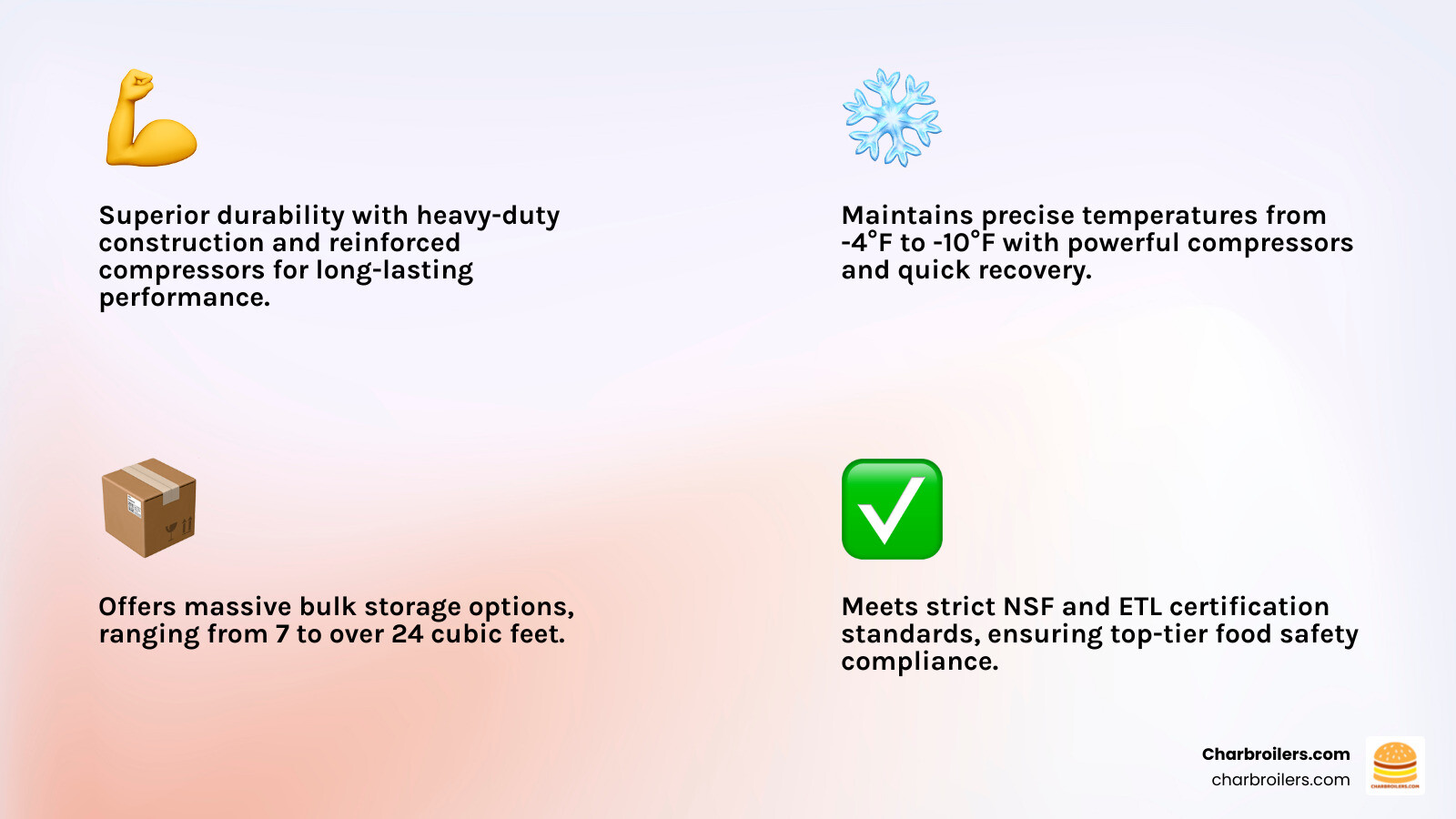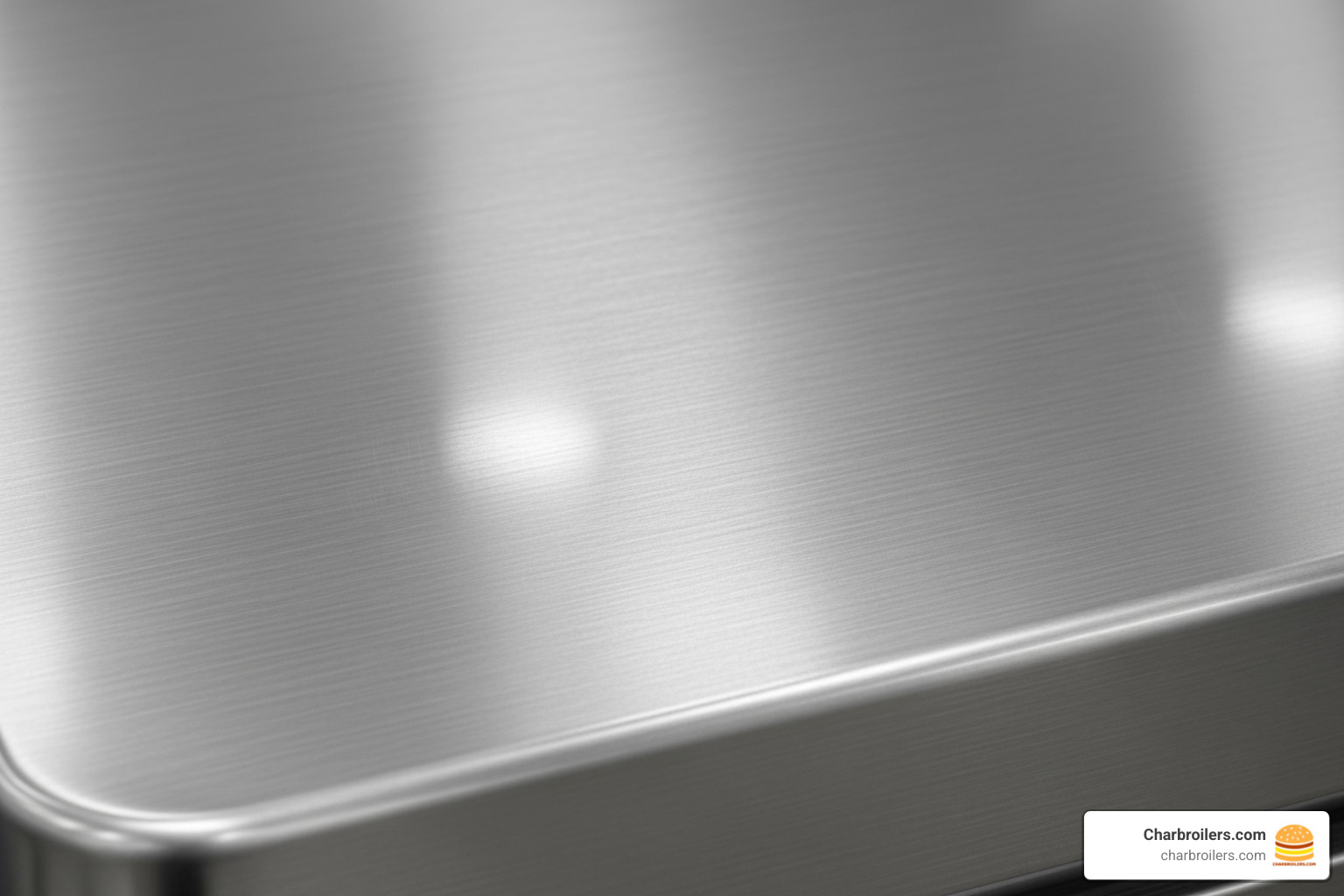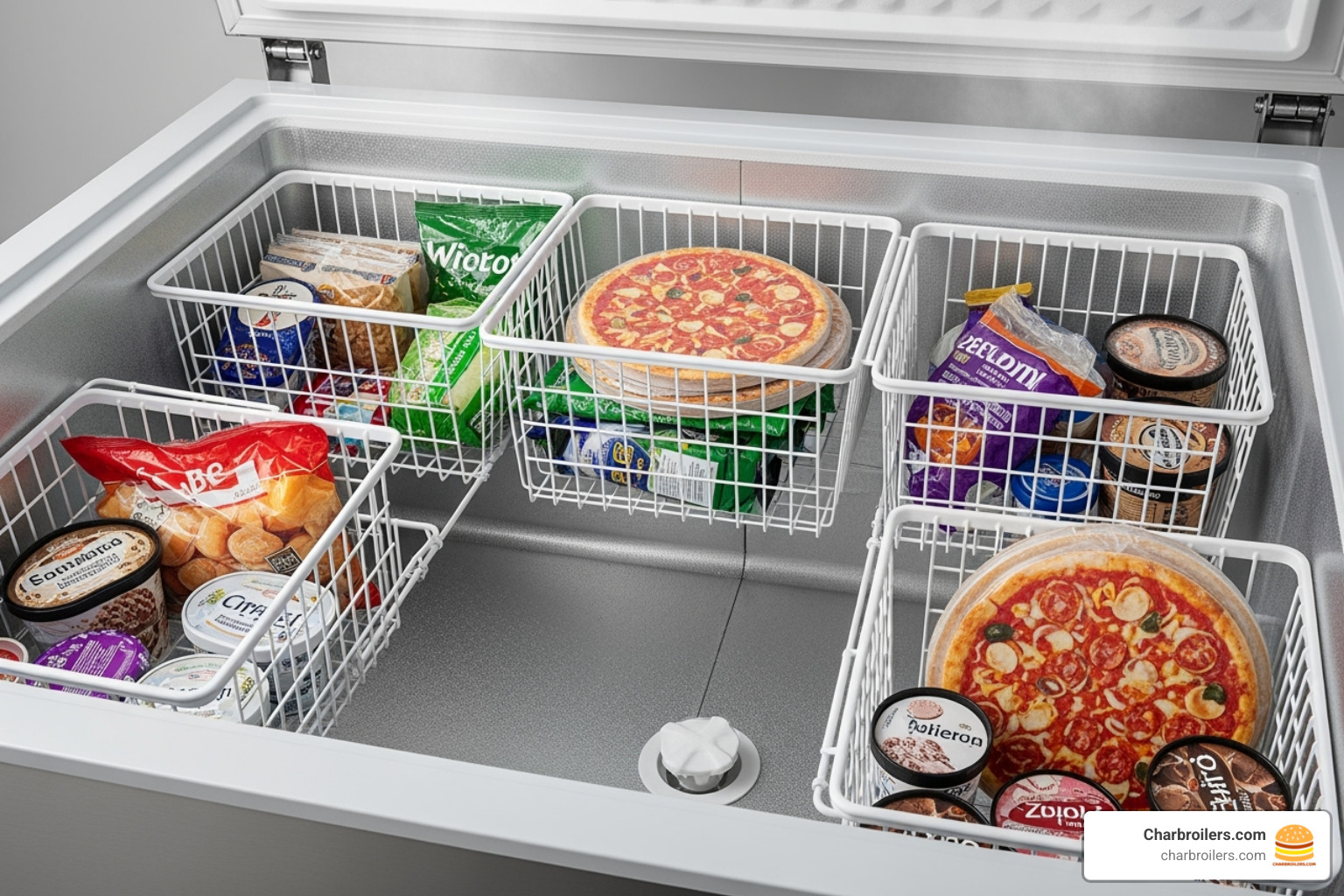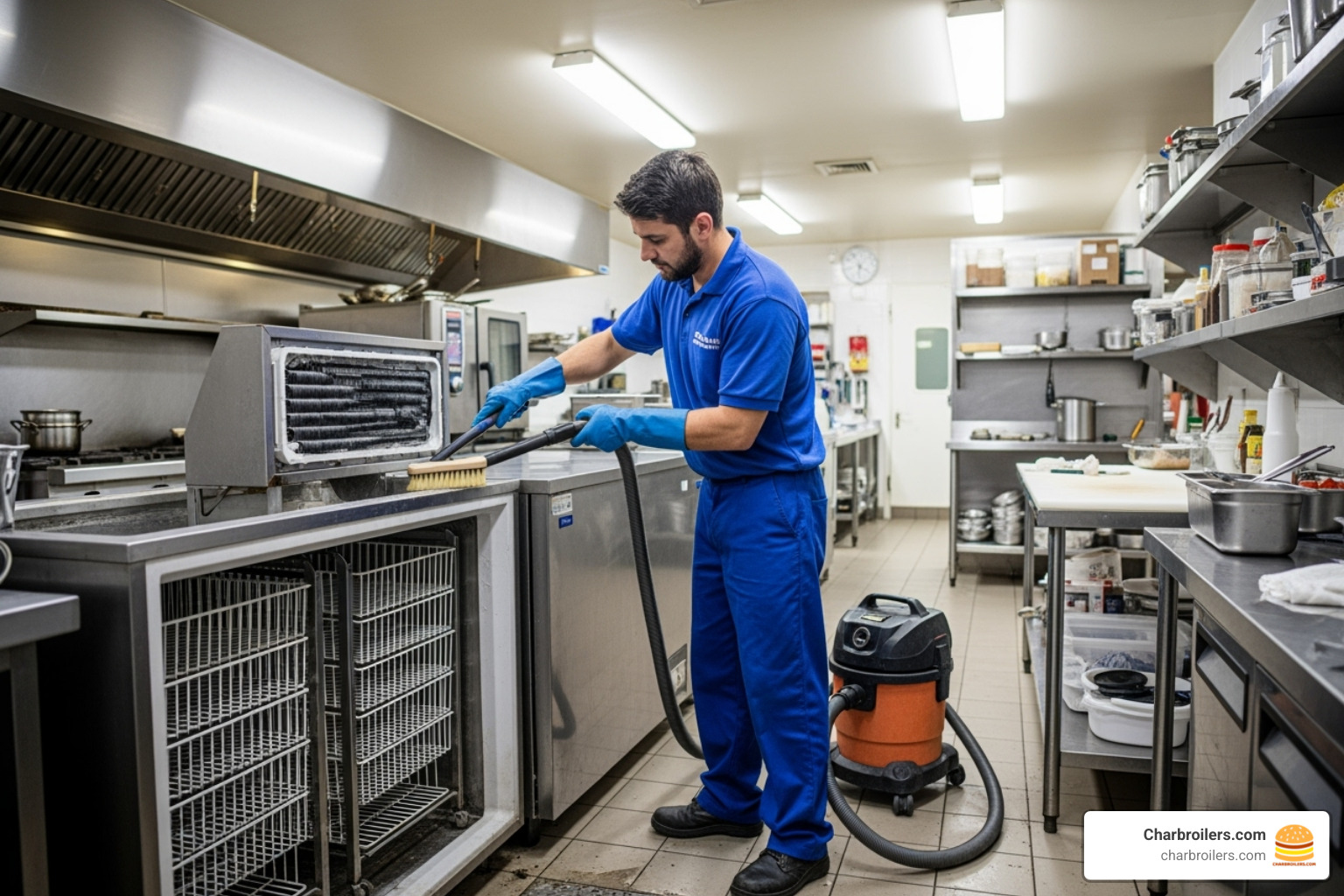
Chill Out with These Stainless Steel Commercial Chest Freezers
Share
Why Your Kitchen Needs a Commercial Chest Freezer
A commercial chest freezer stainless steel unit is the backbone of efficient cold storage in any food service operation. These heavy-duty freezers offer superior temperature consistency, massive storage capacity, and the durability needed to handle constant use in busy commercial kitchens.
Top Commercial Chest Freezer Features:
- Capacity: 7-24+ cubic feet for bulk storage
- Temperature Range: -4°F to -10°F consistent cooling
- Construction: Stainless steel exterior with aluminum interior
- Security: Locking lids with safety gaskets
- Mobility: Built-in casters for easy positioning
- Certifications: NSF and ETL approved for food safety
Commercial chest freezers differ dramatically from residential models. They feature powerful compressors that recover quickly after door openings, maintaining food safety even during busy service periods. The research shows that chest freezers retain cold air more efficiently than upright models because "cold air is retained in the storage compartment even if the lid is not fully closed."
These units excel at bulk storage - perfect for restaurants buying meat in quantity, ice cream shops storing multiple flavors, or any operation needing reliable frozen storage. With capacities ranging from compact 7 cubic feet to massive 24+ cubic feet models, there's a size for every kitchen.
Food safety is paramount in commercial operations. Commercial freezers maintain strict temperature ranges and meet NSF certification standards, ensuring your frozen inventory stays safe and your business stays compliant with health codes.
I'm Sean Kearney from Charbroilers.com, and with over a decade in the restaurant equipment industry, I've helped countless operators find the perfect commercial chest freezer stainless steel solution for their needs. My experience has shown me exactly what busy kitchens require for reliable cold storage.

Easy commercial chest freezer stainless steel glossary:
The Stainless Steel Advantage: More Than Just Good Looks
Stainless steel looks absolutely stunning in any kitchen – that polished, professional appearance never goes out of style. But when you're investing in a commercial chest freezer stainless steel unit, you're getting so much more than eye candy. You're getting a material that's practically engineered for the chaos and demands of commercial food service.

Think about what your freezer faces every single day. Steam from the dishwasher, splashes from prep work, the occasional bump from a busy server rushing by. Stainless steel handles it all with grace. Its corrosion resistance means it won't rust or deteriorate, even in humid kitchen environments. The non-porous surface creates a barrier that bacteria simply can't penetrate, making your daily cleaning routine actually effective.
Here's what really gets me excited about stainless steel – it's incredibly easy to clean. After a long shift, the last thing you want is equipment that fights you during cleanup. A quick wipe-down with the right sanitizer, and your freezer looks brand new again. Plus, stainless steel is non-reactive with food, so you never have to worry about off-flavors or chemical interactions affecting your ingredients.
The heat resistance is another bonus that often gets overlooked. Your freezer might be cold inside, but the kitchen around it sure isn't. Stainless steel won't warp or discolor from the heat of nearby grills or ovens.
And let's talk dollars and cents for a moment. That resale value is real. When it's time to upgrade or relocate, a well-maintained stainless steel unit holds its worth far better than other materials. For more insights on choosing the right materials and features, check out our Detailed Guide to Comparing Commercial Refrigerators.
Built to Withstand the Commercial Kitchen
Picture your busiest Friday night. Orders flying, staff moving fast, and inevitably, someone's going to bump into your freezer. Maybe a cart clips the corner, or a prep cook accidentally drops something heavy nearby. This is exactly why heavy-duty construction matters.
Stainless steel isn't just tough – it's practically bulletproof in kitchen terms. The dent resistance means those unavoidable bumps and knocks won't leave permanent battle scars. The scratch resistance keeps your investment looking professional, even after months of heavy use.
What really impresses me is the longevity factor. I've seen stainless steel units running strong after 15+ years in high-traffic environments. That's not luck – that's engineering. When you're dealing with the daily grind of a commercial kitchen, you need equipment that won't quit on you during the dinner rush.
Your commercial chest freezer stainless steel becomes true investment protection. While other materials might show their age after a few years, stainless steel just keeps going, maintaining both its performance and appearance through whatever your kitchen throws at it.
Superior Hygiene for Food Safety Compliance
Food safety isn't just about following rules – it's about protecting your customers and your reputation. This is where stainless steel really earns its keep. The smooth, non-porous surface creates an environment where bacteria simply can't establish a foothold.
Unlike other materials that might have tiny crevices or porous areas where pathogens can hide, stainless steel gives you a fighting chance. It actively prevents bacteria growth by eliminating those microscopic hiding spots that make sanitization nearly impossible.
Meeting NSF standards isn't optional in commercial food service – it's the law. Our stainless steel units are designed with these standards in mind, making easy sanitization part of your daily routine rather than a struggle. When health inspectors come calling, you'll have confidence in your equipment.
The fact that stainless steel is non-reactive with food gives you another layer of protection. Your frozen ingredients maintain their intended flavor and quality without any unwanted chemical interactions. It's one less thing to worry about when you're focused on maintaining health codes and delivering great food.
At the end of the day, choosing stainless steel gives you genuine peace of mind. You know your equipment is working with you, not against you, in the never-ending battle to keep food safe and customers happy.
Key Features of a Top-Tier Commercial Chest Freezer Stainless Steel
Choosing the right commercial chest freezer stainless steel unit involves more than just picking the first one you see. It's about understanding the specific features that will optimize your operation, streamline your workflow, and ensure your frozen inventory is perfectly preserved. From how much it can hold to how easy it is to move, every detail matters.

When we evaluate a top-tier commercial chest freezer, we look at its capacity, the temperature range it can maintain, and the type of lid it offers—whether it's a solid hinged lid for maximum insulation or a sliding glass lid for display purposes. Security locks are essential for protecting valuable inventory, and mobility, facilitated by sturdy casters, is crucial for cleaning and reconfiguring your space. We also consider the defrost type (manual vs. automatic) and, increasingly, energy efficiency, as this impacts your operating costs. For a detailed look at specifications, you can See an example spec sheet.
Sizing Up Your Storage: Capacity and Dimensions
Capacity is king when it comes to commercial storage. Measured in cubic feet, the right size for your commercial chest freezer stainless steel depends entirely on your business's volume and specific needs. It's not just about the total cubic feet; it's also about the footprint and how the interior is organized. Many models come with removable baskets, which are incredibly helpful for organizing different types of products and preventing items from getting lost at the bottom of the freezer. Without them, it can feel like a deep dive into the unknown!
Organization is key to efficiency. Imagine rummaging for 10 minutes to find that one specific cut of meat during a busy dinner rush – not ideal! Baskets help keep things tidy and accessible. For operations with limited space, we also offer solutions like our Space Savers: Best Under-Cabinet Freezers for Small Kitchens.
Here's a quick guide to common capacities and what they're best for:
- 7-10 cu. ft.: Ideal for small cafes, coffee shops, or bars needing to store ice, a few specialty ingredients, or overflow. Think of it as your reliable sidekick for daily essentials.
- 15-20 cu. ft.: Perfect for mid-sized restaurants, bakeries, or delis that buy in moderate bulk. This size accommodates larger quantities of meat, prepared foods, or baked goods, keeping your pantry well-stocked without overwhelming your space.
- 20+ cu. ft.: Our behemoths of cold storage, these are designed for large-scale operations, catering companies, or businesses that process and store significant volumes of food. If you're buying by the pallet, this is your jam.
Understanding Your Needs for a Commercial Chest Freezer Stainless Steel
Beyond sheer size, the nuances of a commercial chest freezer stainless steel unit's features can significantly impact its performance and suitability for your specific business. Let's dig into the details that truly matter for maintaining optimal conditions and operational efficiency.
First up, temperature controls. You'll typically find both manual and digital options. While manual controls are straightforward, digital displays offer precise temperature readings, allowing you to monitor conditions with greater accuracy. This is crucial for food safety and compliance, giving you peace of mind that your inventory is always within the safe zone. The industry standard for these units often ranges from -4°F to -10°F, ensuring deep freezing capabilities for various perishable goods.
Indicator lights are another small but mighty feature. They provide at-a-glance confirmation that your freezer is running smoothly, or, more importantly, alert you to any potential issues. Think of them as your freezer's way of saying, "All clear!" or "Hey, something's up!"
Lid gaskets are surprisingly important. These seals are critical for maintaining insulation and preventing cold air from escaping, which directly impacts energy efficiency and temperature consistency. A good, tight seal means less work for your compressor and lower utility bills for you. Speaking of insulation, the thicker it is, the better the freezer retains cold, especially during power outages or frequent openings.
Finally, the type of refrigerant used is a key consideration, especially from an environmental perspective. Many modern commercial freezers, including high-quality commercial chest freezer stainless steel models, use R290 Hydrocarbon refrigerant. This is a highly refined propane that's celebrated for being an environmentally friendly alternative to older HFC refrigerants like R134a and R404a. It's a win-win: efficient cooling with a lower environmental impact. For more options in smaller sizes, check out our Cool Picks: Top Small Commercial Freezers to Keep Your Products Fresh.
Installation and Maintenance for Peak Performance
Getting the most out of your commercial chest freezer stainless steel is like taking care of a reliable kitchen workhorse – treat it right from the start, and it'll serve you faithfully for years. But skip the proper setup or neglect regular maintenance, and you'll find yourself dealing with higher energy bills, unexpected breakdowns, and potentially spoiled inventory. Trust me, I've seen too many operators learn this lesson the hard way!

The foundation of peak performance starts with proper placement. Your freezer needs room to breathe with adequate airflow clearance, and it absolutely must sit on a level surface. I can't stress enough how important it is to keep it away from heat sources – placing a freezer next to your grill is like asking it to run a marathon while wearing a winter coat.
Electrical requirements are another critical piece of the puzzle. These units often need dedicated circuits and specific voltage, so don't just plug it into any available outlet. Getting the NEMA plug types right from day one prevents headaches down the road.
Once your commercial chest freezer stainless steel is humming along, a regular cleaning schedule becomes your best friend. This means wiping down that gorgeous stainless steel exterior, cleaning the interior thoroughly, and – here's the part many people forget – checking those condenser coils. Those coils work incredibly hard, and when they're clogged with kitchen grease and dust, your freezer works overtime.
Don't overlook gasket inspection either. Those rubber seals might seem insignificant, but they're what keep your cold air where it belongs. For more detailed troubleshooting tips, check out our guide on Fixing Common Issues with Imperial Frost-Free Commercial Freezers.
Best Practices for Installation
Setting up your commercial chest freezer stainless steel correctly from the get-go saves you countless headaches later. Think of installation as laying the groundwork for years of reliable service.
Ventilation space is absolutely crucial. Your freezer's condenser coils are like the lungs of the unit – they need room to breathe. I always tell my customers to leave at least a few inches on all sides, especially the back. When coils can't get proper airflow, they overheat, making your compressor work harder and driving up those energy costs.
Here's a mistake I see all too often: placing freezers right next to ovens, griddles, or even under direct sunlight from windows. Your freezer is already working to stay cold – don't make it fight against unnecessary heat sources. Finding a spot away from heat sources might take a bit more planning, but your utility bills will thank you.
Stable flooring matters more than you might think. An uneven surface creates vibrations that stress internal components over time. Use a level during installation – it takes just a few minutes but prevents long-term damage that could cost hundreds in repairs.
When it comes to electrical requirements, don't cut corners. Checking voltage needs and ensuring you have the right NEMA plug types prevents equipment damage and safety hazards. Larger units often need dedicated circuits, and honestly, for anything substantial, I recommend professional setup. It's worth the investment to know everything's connected safely and correctly.
Maintenance Tips for Your Commercial Chest Freezer Stainless Steel
Regular maintenance is where the magic happens – it's what transforms a good freezer into a great long-term investment. The beauty of a commercial chest freezer stainless steel is that with proper care, it'll outlast and outperform just about any other cold storage option.
Manual defrosting is probably the most important routine task for most units. Don't let ice build up beyond about 1/4 inch thick – any more than that, and you're wasting energy and losing storage space. When defrost time comes around, that drain plug usage makes the job so much easier. Just remove the plug, let the water flow, and you're back in business.
Cleaning the interior should happen regularly, especially after defrosting. Use a mild, food-safe cleaner and warm water to wipe down all surfaces. This prevents odors from building up and keeps your storage environment as hygienic as possible.
That beautiful stainless steel exterior needs attention too. Wiping down the exterior with a specialized stainless steel cleaner keeps it looking professional and prevents fingerprints and smudges from becoming permanent fixtures. It's amazing how much a clean, gleaming freezer lifts the whole kitchen's appearance.
Here's the maintenance task that makes the biggest difference but gets forgotten most often: checking condenser coils. These coils, usually located at the back or bottom, collect dust, grease, and kitchen debris like magnets. When they're dirty, they can't release heat efficiently, forcing your compressor to work overtime. Clean them monthly or quarterly, depending on how greasy your kitchen gets.
Finally, gasket maintenance is your secret weapon for energy efficiency. Monitoring temperature consistency often comes down to how well those rubber seals are doing their job. Inspect them regularly for cracks or wear, and here's a simple test: close a dollar bill in the door – if you can pull it out easily, your gasket needs attention. Keeping those seals in good shape ensures your commercial chest freezer stainless steel maintains consistent temperatures while keeping energy costs in check.
Frequently Asked Questions about Commercial Chest Freezers
When you're investing in a commercial chest freezer stainless steel unit, questions naturally come up. We get it – this is a significant purchase that needs to work perfectly for your operation. Over the years, we've helped countless restaurant owners steer these decisions, and certain questions keep coming up. Let me share the answers that matter most.
How often should I defrost a manual defrost chest freezer?
Here's the golden rule: defrost your commercial chest freezer stainless steel when ice buildup reaches about 1/4 inch thick on the interior walls. This isn't just about reclaiming storage space – though that matters too. Ice acts like a thick blanket, forcing your compressor to work overtime just to maintain proper temperatures.
You'll know it's time when you notice your energy bills creeping up, items taking longer to freeze solid, or simply less room for your inventory. In a busy commercial kitchen, this typically means defrosting every few months, though high-traffic freezers might need attention more often.
The actual defrosting process is straightforward. Empty your freezer, turn it off, and let nature take its course. Most commercial units include a handy drain plug at the bottom – just position a bucket underneath and the melted water flows right out. Clean and dry everything thoroughly before restocking. It's a bit of work, but your freezer (and your electric bill) will thank you.
Is a commercial chest freezer more energy-efficient than an upright model?
Absolutely! A commercial chest freezer stainless steel unit typically wins the efficiency battle, and physics is on its side. Cold air is heavy – it naturally wants to sink and stay put. When you lift that chest freezer lid, the cold air remains nestled inside like it's found its favorite spot.
Compare that to opening an upright freezer door, where cold air literally tumbles out onto your feet. Your compressor has to kick into high gear every time someone grabs something, working harder and cycling more frequently to bring temperatures back down.
Chest freezers also benefit from thicker insulation and better lid seals. The horizontal design allows for more robust construction, creating a superior barrier against temperature fluctuations. While upright models offer convenience for organization, chest freezers are the clear winners for energy consumption and maintaining consistent temperatures during busy service periods.
What certifications should I look for in a commercial freezer?
Certifications aren't just fancy stickers – they're your guarantee that your commercial chest freezer stainless steel meets the strict standards your business needs. Think of them as your insurance policy for food safety and regulatory compliance.
NSF (National Sanitation Foundation) certification is absolutely essential. This means your freezer is designed for easy cleaning and sanitization, preventing bacteria growth and keeping your operation compliant with health codes. NSF standards focus on public health protection, ensuring every surface and component can be properly maintained.
ETL Sanitation certification works hand-in-hand with NSF, confirming your equipment meets North American sanitation requirements for food service. You'll often see this paired with UL certification for electrical safety, giving you complete peace of mind.
When shopping for your freezer, look for units that carry both NSF and ETL certifications. These aren't just nice-to-have features – they're essential for protecting your customers, maintaining food safety standards, and keeping your business on the right side of health inspectors. It's the smart way to invest in equipment that truly supports your operation's success.
Conclusion: The Ultimate Investment in Cold Storage
When you're running a busy kitchen, every piece of equipment needs to earn its keep. A commercial chest freezer stainless steel unit doesn't just earn its keep – it becomes the reliable workhorse that keeps your operation running smoothly, day after day.
Think about everything we've covered together. The powerful compressors that bounce back quickly after busy dinner rushes. The massive storage capacity that lets you buy smart and store bulk. The temperature consistency that keeps your expensive inventory safe. These aren't just nice features – they're the foundation of a profitable food service operation.
But here's what really sets these units apart: that beautiful stainless steel construction. It's not about looking good (though it certainly does). It's about durability that stands up to whatever your kitchen throws at it. It's about hygiene that keeps health inspectors happy and your customers safe. It's about easy cleaning that saves your staff time and headaches.
The truth is, choosing the right commercial chest freezer stainless steel transforms how you handle food storage. No more worrying about spoilage eating into your profits. No more cramped storage situations during busy seasons. No more equipment breaking down when you need it most.
Your food quality stays pristine, your workflow becomes smoother, and your bottom line benefits from reduced waste and improved efficiency. It's one of those investments that pays you back in ways you might not even notice at first – until you can't imagine operating without it.
At Charbroilers.com, we've helped countless food service operators find their perfect cold storage solution. We understand that every kitchen is different, every operation has unique needs, and every budget has its constraints. That's why we're here to guide you through the process, ensuring you get exactly what your business needs to thrive.
Ready to explore more ways to keep your kitchen running at peak performance? Check out our comprehensive guide: Keep Your Cool with These Restaurant-Ready Commercial Refrigerators. Your future self (and your profit margins) will thank you.
